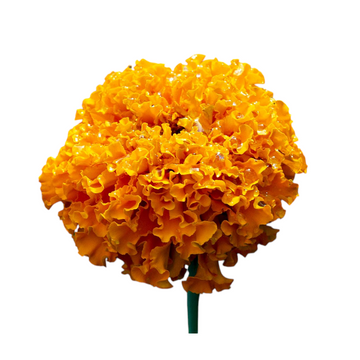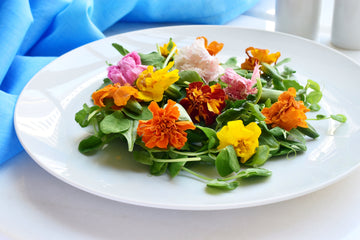Orange African Marigold

Freshly Harvested

Non-GMO & Natural

Nutrient Dense

Trusted by Chefs
15 Seeds+
🌼 Orange African Marigold Seeds
Tagetes erecta
A giant among marigolds 🌿🌞, Orange African Marigold produces bold, globe-shaped blooms in blazing orange 🧡🔥. Towering above most varieties, this heirloom favorite reaches impressive heights while delivering edible petals long used in global cuisine as a coloring and flavoring agent. Known as the “poor man’s saffron” in parts of Asia and Latin America, its petals bring golden tones and a mild, citrusy-peppery taste to dishes, teas, and oils. Ornamental, edible, and pest-repelling 🌱🐜 — it’s a powerhouse plant for gardens and kitchens alike.
👅 Flavor Profile:
Mildly citrus 🍊, peppery 🌶️, slightly bitter 🌿, saffron-like undertones ✨.
🍴 Culinary Uses:
🥗 Scatter petals in salads for fiery orange color and tang
🥘 Infuse petals into rice, curries, and soups as a saffron substitute
🍵 Brew into herbal teas for earthy-citrus notes
🍸 Float petals in cocktails for bold visual flair
🧄 Infuse oils & vinegars for golden hue + subtle spice
👨🍳 Chef’s Pitch:
Orange African Marigold is the chef’s golden bloom 🌼👨🍳💎. With its massive orange pom-poms and versatile petals, it doubles as a dramatic garnish and a natural dye. Perfect for global-inspired cooking, mixology, and gourmet plating, this marigold brings bold color, subtle flavor, and timeless heritage to the kitchen.
🌱 Growing Notes:
🪴 Tall annual, 24–36” (sometimes taller), upright growth
🌼 Huge orange pom-pom flowers, continuous bloomer
🌞 Thrives in full sun, heat-tolerant & drought-resistant
🐝 Pollinator-friendly + natural pest deterrent (repels nematodes & aphids)
⏱ Long bloom season: summer → frost
✨ Quick Facts:
-
Latin Name: Tagetes erecta (‘Orange African Marigold’)
-
Habit: Annual, tall 24–36”+
-
Flavor: Citrus, peppery, saffron-like
-
Culinary Uses: Salads, teas, cocktails, rice, oils
-
Special Use: Dramatic cut flower + natural pest control

Orange African Marigold

Let’s Manifest Beauty.
Edible Flowers that Smile.
Edible flowers are more than just decoration — they’re a chef’s secret for adding elegance, fragrance, and subtle flavor to a dish. From citrusy marigolds to honey-sweet alyssum and tangy begonias, these delicate blooms transform plates into experiences. Each petal offers color, aroma, and taste, turning simple ingredients into a culinary statement.

Flowers are here to stay
The Art of Garnishing with Edible Flowers
A garnish should do more than decorate — it should enhance. Edible flowers bring color, fragrance, and subtle flavor to the plate, turning simple dishes into memorable experiences. From delicate petals scattered across a salad to a single bloom crowning a dessert, flowers add elegance and elevate presentation in ways that engage every sense.
The Secret Ingredient Chefs Trust
Widely used in professional kitchens, microgreens enhance flavor profiles while adding nutrition and a striking visual appeal to everything from sandwiches to fine dining creations.
Frequent Asked Questions
Q: What are Microgreens?
Microgreens are young, tender plants harvested just after the first leaves develop. They’re packed with flavor, color, and nutrients, making them both delicious and healthy.
Q: Are microgreens really more nutritious than regular vegetables?
Yes. Research shows that microgreens can contain up to 40x more vitamins and antioxidants (like A, C, K, and E) compared to their mature counterparts.
Q: How do I use microgreens in my meals?
They’re incredibly versatile—use them as a garnish, in salads, on sandwiches, in wraps, smoothies, soups, or even as a centerpiece ingredient in gourmet dishes.
Q: How long do microgreens stay fresh?
Stored properly in a fridge, microgreens typically last 5–7 days. To keep them at peak freshness, store them dry in a breathable container.











